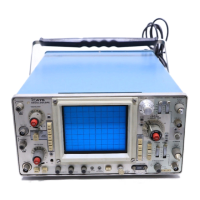TM 11-6625-2735-14-1
b. HIGH VOLTAGE (Check oscillator and regulator,
over-voltage protection circuit and secondary load.)
c. A SWEEP (Set TRIG MODE to AUTO; repair until
sweep is repetitive.)
d. HORIZONTAL AMPLIFIER (Turn horizontal POSl-
TION; repair until each deflection plate output has proper
voltage swing.)
e. VERTICAL OUTPUT AMPLIFIER (Turn vertical
POSITION; repair until each deflection plate output has
proper voltage swing.)
f. Z AXIS (set TRIG MODE to SINGL SWP; repair until
spot display is controlled by INTENSITY.)
g. All remaining inoperative functions.
The preceding recommended troubleshooting se-
quence is intended to be a quick approach to circuit
troubleshooting. See Special Troubleshooting informa-
tion listing in this section for detailed troubleshooting
instructions.
Fig. 4-4 provides a guide in locating a defective circuit.
This chart may not include checks for all possible defects;
use steps 7 through 9 in such cases. Start from the top of
the chart and perform the given checks on the left side of
the page until a step is found which does not produce the
indicated results. Further checks and/or the circuit in
which the trouble is probably located are listed to the right
of this step.
After the defective circuit has been located, it may be
helpful to read the applicable part of the Circuit Descrip-
tion section and Special Troubleshooting Information part
of this section to aid in locating defective components.
After doing this, see steps 7 through 9 for additional
information.
7. Check Circuit Board Interconnections. After the
trouble has been isolated to a particular circuit, check for
loose or broken connections at circuit-board interconnec-
ting pins, plugs and end-lead connectors.
8. Check Voltages and Waveforms.
Often the defective
component can be located by checking for the correct
voltage or waveform in the circuit. Typical voltages and
waveforms are given on the diagrams.
NOTE
Voltages and waveforms given on the diagrams are
not absolute and may vary slightly between in-
nstruments. To obtain operating conditions similar to
those used to take these readings, see the voltage
and waveforms page with each schematic diagram.
On this page, note the recommended test equip-
ment, front-panel control settings, voltage and
waveform conditions, and test equipment cable
connection Instructions. Voltages and waveforms
given on the schematics should be checked against
each instrument while it is operating properly.
Deviations should be noted on the schematics for
later reference.
9. Check Individual Components. The following
procedures describe methods of checking individual
components. Components which are soldered in place
should be checked after disconnecting one end from the
circuit. This isolates the measurement from the effects of
surrounding circuitry.
a. SEMICONDUCTORS
Power switch must be turned off before removing or
replacing components.
A good check of transistor operation is actual in-circuit
performance under operating conditions and most tran-
sistors in the 475 can be checked this way. A transistor can
be most effectively checked by substituting a new compo-
nent for it (or one which has been checked previously).
However, be sure that circuit conditions are not such that a
replacement transistor might also be damaged. If sub-
stitute transistors are not available, use a dynamic tester.
Static-type testers are not recommended, since they do
not check operation under simulated operating con-
ditions.
When troubleshooting transistors with a voltmeter,
measure the emitter-to-base and emitter-to-collector
voltages to determine if the voltages are consistent with
normal circuit voltage. Voltages across a transistor vary
with the type of device and its circuit function. Some of
these voltages are predictable. The emitter-to-base
voltage of a conducting silicon transistor wiII normally be
0.6 to 0.8 volts. The emitter-to-collector voltage of
saturated transistors is approximately 0.2 volts. Because
these values are small, the best way to check them is by
connecting the voltmeter across the junction and using a
sensitive voltmeter setting, rather than by comparing 2
voltages taken with respect to ground (both leads of the
voltmeter must be isolated from ground if this method is
used.
4-11

